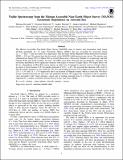Visible spectroscopy from the Mission Accessible Near-Earth Object Survey (MANOS): taxonomic dependence on asteroid size
Author(s)
Person, Michael J; Binzel, Richard P; DeMeo, Francesca E
DownloadPublished version (2.572Mb)
Publisher Policy
Publisher Policy
Article is made available in accordance with the publisher's policy and may be subject to US copyright law. Please refer to the publisher's site for terms of use.
Terms of use
Metadata
Show full item recordAbstract
The Mission Accessible Near-Earth Object Survey (MANOS) aims to observe and characterize small (mean absolute magnitude H ~ 25 mag) Near-Earth Objects (NEOs) that are accessible by spacecraft (mean Δv ~ 5.7 km s−1) and that make close approaches with the Earth (mean Minimum Orbital Intersection Distance MOID ~ 0.03 au). We present here the first results of the MANOS visible spectroscopic survey. The spectra were obtained from August 2013 to March 2018 at Lowell Observatory's Discovery Channel 4.3 m telescope, and both Gemini North and South facilities. In total, 210 NEOs have been observed and taxonomically classified. Our taxonomic distribution shows significant variations with respect to surveys of larger objects. We suspect these to be due to a dependence of Main Belt source regions on object size. Compared to previous surveys of larger objects, we report a lower fraction of S+Q-complex asteroids of 43.8 ± 4.6%. We associate this decrease with a lack of Phocaea family members at very small size. We also report higher fractions of X-complex and A-type asteroids of 23.8 ± 3.3% and 3.8 ± 1.3% respectively due to an increase of Hungaria family objects at small size. We find a strong correlation between the Q/S ratio and perihelion distance. We suggest this correlation is due to planetary close encounters with Venus playing a major role in turning asteroids from S to Q-type. This hypothesis is supported by a similar correlation between the Q/S ratio and Venus MOID. ©2019 Keywords: catalogs; minor planets: asteroids, general; surveys
Date issued
2019-10Department
Massachusetts Institute of Technology. Department of Earth, Atmospheric, and Planetary SciencesJournal
Astronomical journal
Publisher
American Astronomical Society
Citation
Devogèle, Maxime, et al., "Visible spectroscopy from the Mission Accessible Near-Earth Object Survey (MANOS): taxonomic dependence on asteroid size." Astronomical journal 158, 5 (2019): no. 196 doi 10.3847/1538-3881/AB43DD ©2019 Author(s)
Version: Final published version
ISSN
1538-3881
2328-2819